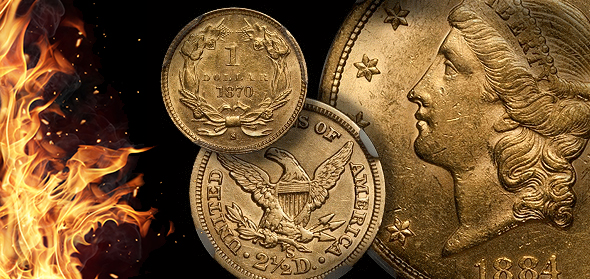
By Doug Winter – Douglas Winter Numismatics ……
I’ve written a lot about the 19th century gold coinage from the San Francisco mint, but it’s been awhile since I’ve discussed the “heat factor” for the various types and denominations from this mint. Clearly, San Francisco gold has gone from “unloved” to “up and coming” in the last few years, but which specific series are hot and which are not? Let’s take a look at each series and let me share my thoughts about the gold coin market with you.
1. Gold Dollars
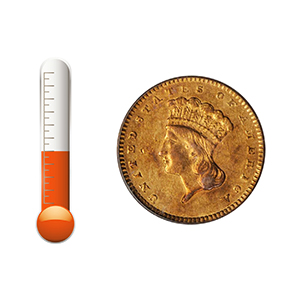 As recently as a few years ago, most San Francisco gold dollars were, to put it generously, “difficult” to sell. But as a result of a strong push from me (I love these coins and find them both eminently collectible and numismatically interesting) and others, there are now a numbers of collectors putting together date sets of these coins in the AU and lower Uncirculated grades.
As recently as a few years ago, most San Francisco gold dollars were, to put it generously, “difficult” to sell. But as a result of a strong push from me (I love these coins and find them both eminently collectible and numismatically interesting) and others, there are now a numbers of collectors putting together date sets of these coins in the AU and lower Uncirculated grades.
This summer, Heritage is auctioning the fantastic Duckor Collection of Gold Dollars, and this set contains high-grade examples of nearly all the dates from San Francisco. I feel strongly that some records will be set and that this will be a case of a rising tide lifting some (but not all) boats.
Despite a definite increase in interest, I haven’t really seen prices rise for San Francisco gold dollars. A little bit of money goes a long way in this series and you can still purchase really nice coins for $1,500-2,500. The only thing keep these coins from (numismatic) World Domination is their size.
HEAT INDEX: Somewhat warm, with the possibility of increased heat after the ANA sale this summer.
2. Quarter Eagles
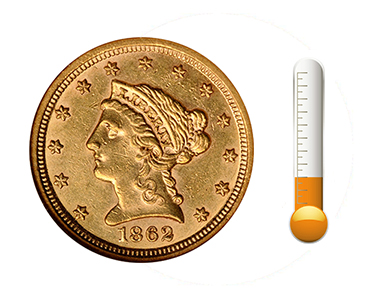 If I were a collector setting out on a set building project, one group of coins I would consider strongly would be the quarter eagles from San Francisco. With the exception of the very rare 1854-S (see below for a separate discussion on this issue) all of the other 21 issues are reasonably affordable, and most can be found in comparatively high grades.
If I were a collector setting out on a set building project, one group of coins I would consider strongly would be the quarter eagles from San Francisco. With the exception of the very rare 1854-S (see below for a separate discussion on this issue) all of the other 21 issues are reasonably affordable, and most can be found in comparatively high grades.
Despite all the positives of this series, it still really hasn’t caught on with collectors the way I think it should. There are individual issues which are popular (namely the 1861-S, 1862-S, and 1863-S for their Civil War association) but there are many which seem, at least to me, to be much under-appreciated given their scarcity.
I think this relative lack of popularity has more to do with these coins status as quarter eagles than their San Francisco origin. Quarter eagles trail their larger counterparts in number of serious collectors for a number of reasons.
The 1854-S is an issue which transcends its status as a “San Francisco quarter eagle.” It has finally attained its deserved status as a Classic Rarity and when the Bass-Pogue finest known example sells sometime in the near future (2016 or 2017) a new spectrum of collectors will be introduced to the charms of this date.
I personally believe San Francisco quarter eagles have real upside, but I wouldn’t count on this series catching fire anytime soon.
HEAT INDEX: Currently lukewarm except for the hot 1854-S and the molten hot Civil War issues (1861-S, 1862-S, 1863-S, and 1865-S).
3. Three Dollar Gold Pieces
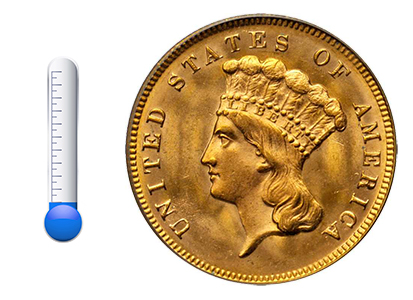 As I have mentioned before, the Three Dollar series still has not recovered since its Golden Era of 2005-2008, when it was the beneficiary of a book by Dave Bowers and me, and the recipient of a push by my firm and others. The last decade has been pretty much lonely times for Three Dollar specialists.
As I have mentioned before, the Three Dollar series still has not recovered since its Golden Era of 2005-2008, when it was the beneficiary of a book by Dave Bowers and me, and the recipient of a push by my firm and others. The last decade has been pretty much lonely times for Three Dollar specialists.
But I think there is some hope on the horizon. In the second group of coins salvaged off the S.S. Central America, it is rumored that there are some neat San Francisco Threes and this could lead to some renewed collector interest. There is also the what goes around comes around theory which basically states that after a generation of indifference, new collectors are attracted to what the last generation ignored.
My biggest problem with San Francisco three dollar gold pieces is that I don’t like the coins that I’m offered these days. As an example, I love the numismatic significance of the first year of issue 1855-S. But almost all of the ones I see in holders are yucky and certainly not the quality that I want to offer to DWN clients.
What is the future of this series? It’s hard to predict but these currently-unloved numismatic oddballs are aching to be loved.
HEAT INDEX: Currently cold but who knows about the future.
4. Liberty Head Half Eagles, No Motto
 As recently as five years ago, a coin like an AU55 1861-S half eagle would have elicited the following response from me if another dealer offered it for sale: “great coin but so hard to sell…” Fast forward to mid-2015 and I’d buy three 1861-S half eagles in AU55 if I could only find them.
As recently as five years ago, a coin like an AU55 1861-S half eagle would have elicited the following response from me if another dealer offered it for sale: “great coin but so hard to sell…” Fast forward to mid-2015 and I’d buy three 1861-S half eagles in AU55 if I could only find them.
As a denomination, the heat index for half eagles is higher than in the past, and San Francisco No Motto coins are helping to lead the charge. Absolute rarity is in vogue in today’s rare date gold market and it’s hard not to like rare issues like the 1858-S, 1860-S, 1862-S, 1863-S, 1864-S, and 1866-S No Motto which are genuinely rare with no more than 50 or so known in all grades.
To my way of thinking there are only two things holding back No Motto San Francisco half eagles from more popularity. The first is a lack of available coins. The second is the already-high price of the rarer issues which will naturally limit the number of potential buyers.
HEAT INDEX: Warm to very warm, but could be a victim of its own popularity; how will new collectors find coins?
5. Liberty Head Half Eagles, With Motto
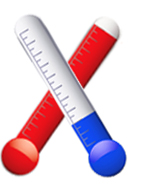 This series can actually be divided in two: the rare 1866 through 1877 issues, and the (mostly) common dates from 1877 through 1906. The rarer dates are typically collected along with the No Motto dates (see above), while the common dates are currently relegated (mostly) to the slightly-better-than-generic-but-good-luck-getting-a-premium status.
This series can actually be divided in two: the rare 1866 through 1877 issues, and the (mostly) common dates from 1877 through 1906. The rarer dates are typically collected along with the No Motto dates (see above), while the common dates are currently relegated (mostly) to the slightly-better-than-generic-but-good-luck-getting-a-premium status.
In my opinion, the better dates from the 1860’s and the 1870’s (namely the 1866-S Motto, 1867-S, 1870-S, 1875-S, and 1876-S) are way undervalued. And there are sleepers from the 1880’s and the 1890’s (1883-S, 1894-S, 1895-S, and 1896-S) which are even more undervalued.
I’m not sure I see the With Motto half eagles from San Francisco as a series which will be collected by date. Which is sort of a shame as this is a 38 coin set which is 100% completable. The problem with it as a series is its oddball mixture of rare and common dates. It is hard to find a collector who is content to buy coins in EF grades and MS64 grades which is what the typical set of With Motto San Francisco half eagles is likely to consist of.
HEAT INDEX: Bifurcation supreme. The rare early dates are warm to very warm, while the semi-common and generic issues are cold to frozen stiff.
6. Liberty Head Eagles, No Motto
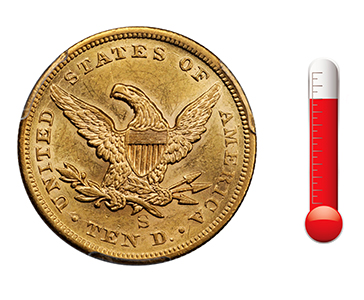 Viewed as a whole, the Liberty Head eagle series has gained more of a collector following in the last few years than maybe any other series in the entire world of rare date gold. And it is hard to think of any other part of the whole which has seen more new collector interest than No Motto eagles from the San Francisco mint.
Viewed as a whole, the Liberty Head eagle series has gained more of a collector following in the last few years than maybe any other series in the entire world of rare date gold. And it is hard to think of any other part of the whole which has seen more new collector interest than No Motto eagles from the San Francisco mint.
While there are no uncollectable issues in the San Francisco No Motto eagle set, nearly every issue is a challenge, especially if a collector is interested in high-quality coins with natural color and pleasing surfaces. Even such relatively available coins as the 1854-S, 1856-S, and 1857-S are scarce to rare in the higher AU grades. And then there are issues like the 1859-S, 1860-S, 1862-S, 1863-S, 1864-S, and 1865-S Normal Date which are both fundamentally rare, and rare in terms of grade.
Despite the obvious challenges posed by this series, the number of collectors focusing on No Motto eagles from San Francisco has likely tripled in the last few years. Ironically, the scarcity of these coins can’t support many more new collectors as the supply/demand ratio of such rare coins can be easily affected by the introduction of new collectors.
It is likely that the already-high prices of the rare issues in this set will scare off possible new collectors. But a result of these high prices is a new focus on lower grade coins; pieces graded as low as VG to Fine have spiked in demand and price along with their higher grade counterparts.
HEAT INDEX: Hot to very hot, and not just for Condition Census and near-Condition Census coins but for nice quality lower grade examples of the rarer dates of this type as well.
7. Liberty Head Eagles With Motto
 As with the half eagles of this types (see #5, above) this series can be neatly divided in two: the rare 1866 through 1877 issues and the (mostly) common dates from 1878 through 1907. The rarer dates are often collected along with the No Motto eagles, while the common and slightly scarce dates are relegated to also-ran status for the time being.
As with the half eagles of this types (see #5, above) this series can be neatly divided in two: the rare 1866 through 1877 issues and the (mostly) common dates from 1878 through 1907. The rarer dates are often collected along with the No Motto eagles, while the common and slightly scarce dates are relegated to also-ran status for the time being.
Again, the rarity status of the early date With Motto eagles from San Francisco has similarities to the With Motto half eagles. There are a number of dates (1866-S Motto, 1867-S, 1870-S, 1873-S, 1876-S) which are undervalued; some dramatically. And there are sleepers galore from the common date era: 1883-S, 1894-S, 1895-S, 1896-S, 1905-S, and 1907-S to name a few.
If a marketing company or a large retailer were to promote the 1880-1907 dates, it is possible that these could become popular with date collectors. However, it is more likely that whatever interest there is on With Motto San Francisco eagles will be focused on the 1866-1877 issues.
HEAT INDEX: Again…bifurcation supreme. The rare early dates are warm to very warm, while the semi-common and generic issues are cold to frozen stiff.
8. Liberty Head Double Eagles, Type One
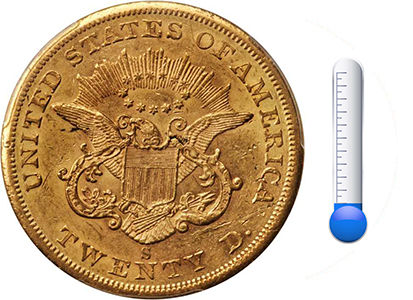 After many years of extreme popularity, the demand for Type One San Francisco double eagles (with some notable exceptions; see below) has lessened and prices have stabilized. This is partially due to a large supply of dates other than the ubiquitous 1857-S, and a lag in demand due to a major player in this market shifting their attention onto other series.
After many years of extreme popularity, the demand for Type One San Francisco double eagles (with some notable exceptions; see below) has lessened and prices have stabilized. This is partially due to a large supply of dates other than the ubiquitous 1857-S, and a lag in demand due to a major player in this market shifting their attention onto other series.
There are some exceptions. Demand for the key issues (1854-S, 1861-S Paquet Reverse, and 1866-S No Motto) remains strong and prices appear to still be rising for these three dates in nearly all grades.
It will be interesting to see the market’s reaction to the new round of S.S. Central America coins which are likely to hit the market in the near future. Will these kill the market for the first group of SSCA double eagles—particularly the 1857-S—or rekindle collector interest and bring new people into the market?
HEAT INDEX: Mostly cold, but the three key San Francisco dates remain very warm to hot.
9. Liberty Head Double Eagles, Type Two
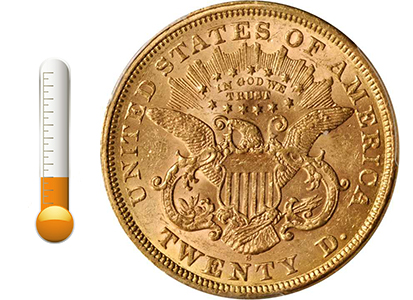 With the exception of the popular Carson City issues, the entire Type Two market has seemed fairly uninspiring over the last decade; although if you study auction prices for high-grade examples of many better issues, the level of strength is surprising.
With the exception of the popular Carson City issues, the entire Type Two market has seemed fairly uninspiring over the last decade; although if you study auction prices for high-grade examples of many better issues, the level of strength is surprising.
The 11-coin San Francisco Type Two date set should be much more avidly collected than it currently is. It has many things going for it: completability, large size, interesting design, historic significance, and high-grade scarcity. I could easily see demand for date sets rise appreciably with some creative marketing.
The entire Type Two market seems “musty” to me. It’s time for a new Type Two book, and it seems like a good time for an entire re-thinking of the numismatic significance of the entire series.
HEAT INDEX: Lukewarm at best, but of all the various San Francisco gold types this seems the most likely to change its status to “hot” in a year or two.
10. Liberty Head Double Eagles, Type Three
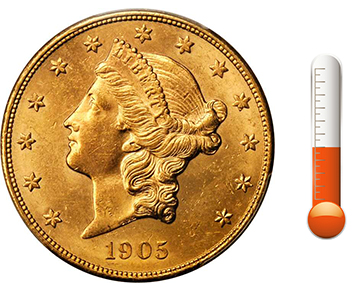 The discovery of hundreds and hundreds of choice, high-grade Type Three San Francisco double eagles in the Saddle Ridge Hoard focused more attention on this series than ever before. In addition, an excellent new book on Type Three double eagles, written by Michael Fuljenz, is likely to reinvigorate this market as well.
The discovery of hundreds and hundreds of choice, high-grade Type Three San Francisco double eagles in the Saddle Ridge Hoard focused more attention on this series than ever before. In addition, an excellent new book on Type Three double eagles, written by Michael Fuljenz, is likely to reinvigorate this market as well.
The trouble with Type Three San Francisco double eagles is that they are not overly interesting from a numismatic perspective. There are no rarities (although certain dates are conditionally rare) and this makes them less popular than their counterparts from Carson City and Philadelphia. But, by the same token, this lack of rarities makes the 30 coin San Francisco set very easy to complete; even in Uncirculated grades. For less than $75,000, a collector can assemble a really nice set with coins ranging in grade from MS61/62 to MS64.
Given the fact that many Type Three Liberty Head double eagles from San Francisco are essentially “generics,” it will likely take an increase in gold prices to foster some new interest in these coins.
HEAT INDEX: Less hot now than a year ago due to the lack of a Saddle Ridge Hoard aftermarket.
The overall condition of the San Francisco Liberty Head gold market is considerably stronger than it was just a few years ago. I have noticed an influx of new collectors; often younger and often from the Bay Area which are both good signs. And I expect to see continued strength in many specific series within this market, especially for coins struck prior to 1880.
Are you interested in forming a meaningful collection of San Francisco gold coins? I’d like to work with you and can be reached by email at [email protected] or by phone at (214) 675-9897.
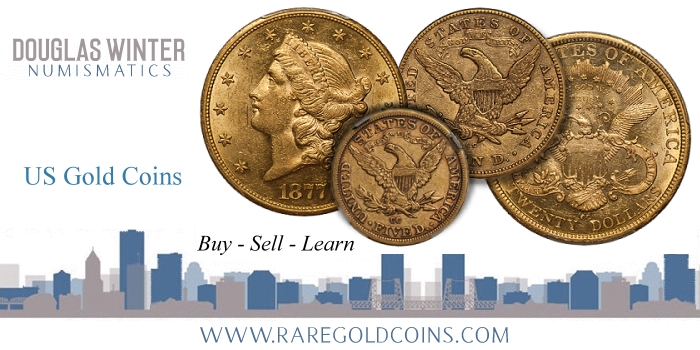
About Doug Winter
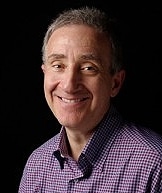 Doug has spent much of his life in the field of numismatics; beginning collecting coins at the age of seven, and by the time he was ten years old, buying and selling coins at conventions in the New York City area.
Doug has spent much of his life in the field of numismatics; beginning collecting coins at the age of seven, and by the time he was ten years old, buying and selling coins at conventions in the New York City area.
In 1989, he founded Douglas Winter Numismatics, and his firm specializes in buying and selling choice and rare United States coins, especially US gold coins and all branch mint material.
Recognized as one of the leading specialized numismatic firms, Doug is an award winning author of over a dozen numismatic books and the recognized expert on US Gold. His knowledge and exceptional eye for properly graded and original coins has made him one of the most respected figures in the numismatic community and a sought after dealer by collectors and investors looking for professional personalized service, a select inventory of impeccable quality and fair and honest pricing. Doug is also a major buyer of all US coins and is always looking to purchase collections both large and small. He can be reached at 214-675-9897.
Doug has been a contributor to the Guidebook of United States Coins (also known as the “Redbook”) since 1983, Walter Breen’s Encyclopedia of United States and Colonial Coins, Q. David Bowers’ Encyclopedia of United States Silver Dollars and Andrew Pollock’s United States Pattern and Related Issues
In addition he has authored 13 books on US Gold coins including:
- Gold Coins of the New Orleans Mint: 1839-1909
- Gold Coins of the Carson City Mint: 1870 – 1893
- Gold Coins of the Charlotte Mint: 1838-1861
- Gold Coins of the Dahlonega Mint 1838-1861
- The United States $3 Gold Pieces 1854-1889
- Carson City Gold Coinage 1870-1893: A Rarity and Condition Census Update
- An Insider’s Guide to Collecting Type One Double Eagles
- The Connoisseur’s Guide to United States Gold Coins
- A Collector’s Guide To Indian Head Quarter Eagles
- The Acadiana Collection of New Orleans Coinage
- Type Three Double Eagles, 1877-1907: A Numismatic History and Analysis
- Gold Coins of the Dahlonega Mint, 1838-1861: A Numismatic History and Analysis
- Type Two Double Eagles, 1866-1876: A Numismatic History and Analysis
Finally Doug is a member of virtually every major numismatic organization, professional trade group and major coin association in the US.
If you are interested in buying or selling classic US coins or if you would like to have the world’s leading expert work with you assembling a set of coins? Contact Doug Winter at (214) 675-9897 or by email at [email protected].




